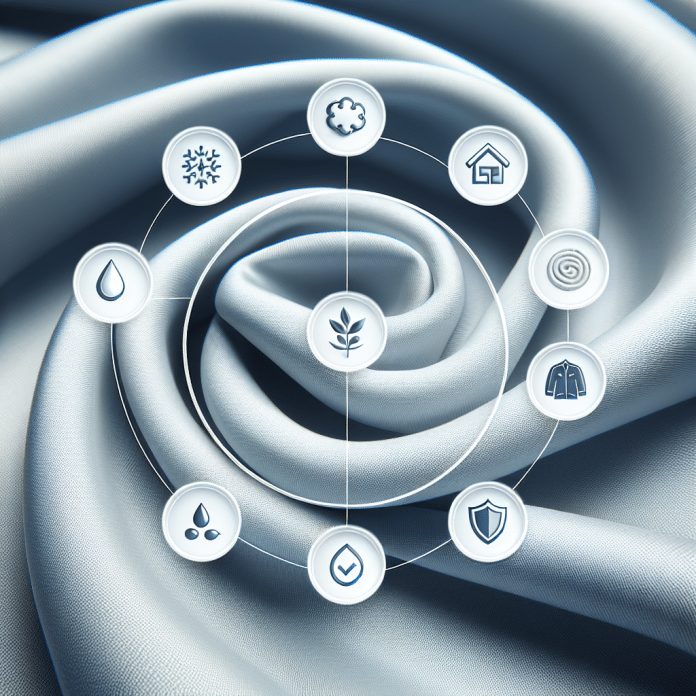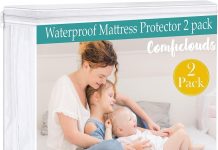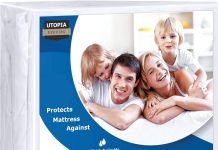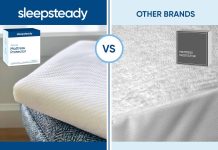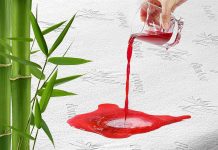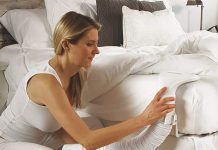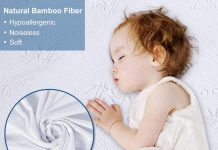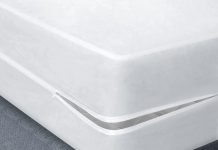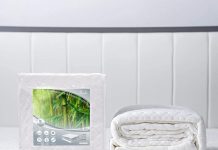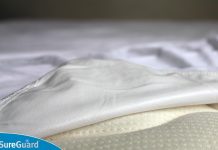Looking for the perfect fabric to protect your precious mattress? Well, look no further! In this article, we will guide you through the multitude of options available and help you choose the best fabric for your mattress protector. From cotton to polyester to bamboo, we’ve got you covered with all the necessary information to make an informed decision. So, get ready to sleep peacefully knowing that your mattress is well-protected, as we unveil the secrets of the best fabric for mattress protectors.
Review contents
Cotton
Cotton is a widely used fabric in the production of mattress protectors, and it offers numerous benefits. Firstly, cotton is naturally breathable, allowing air to circulate and keep you cool and comfortable throughout the night. This breathability also helps to regulate body temperature, preventing you from becoming too hot or too cold while you sleep.
Another advantage of cotton is its excellent moisture absorption properties. This natural fiber can effectively wick away sweat and other moisture, keeping your mattress dry and free from any potential stains or odors. This is particularly beneficial if you tend to sweat heavily during the night or if you have young children who may wet the bed.
Cotton is also known for its durability. It is a strong and sturdy fabric that can withstand regular washing and frequent use without losing its shape or quality. Mattress protectors made from cotton can last for years, making them a cost-effective choice in the long run.
However, it is important to note that cotton does have some drawbacks. One potential drawback is its sensitivity to allergens. Some individuals may be allergic to cotton or may experience skin irritation when in direct contact with it. Additionally, cotton can wrinkle easily, requiring ironing or steaming to maintain a neat appearance.
When it comes to choosing a cotton thread count for your mattress protector, a higher thread count is generally recommended. A higher thread count signifies a tighter weave, which can enhance the durability and longevity of the fabric. A thread count of around 200 to 400 is often considered optimal for cotton mattress protectors.
Polyester
Polyester is another popular fabric choice for mattress protectors, offering its own set of benefits. One of the key advantages of polyester is its water-resistant and stain repellent properties. This fabric has a natural resistance to liquids, making it an excellent choice for protecting your mattress from spills, accidents, and stains.
In terms of breathability, polyester is not as effective as cotton. It tends to trap body heat and moisture, potentially causing discomfort for those who are prone to overheating during the night. However, advancements in fabric technology have led to the development of polyester blends that offer improved breathability while still retaining the water-resistant properties.
One of the major benefits of polyester is its wrinkle resistance. Unlike cotton, polyester does not easily wrinkle or crease, so you won’t have to spend time ironing or steaming your mattress protector to keep it looking neat and inviting.
Polyester is known for its longevity and durability. It is a robust fabric that can withstand regular use and cleaning without losing its shape or effectiveness. If you prioritize durability in your mattress protector, polyester may be an excellent choice.
Bamboo
Bamboo is a relatively new addition to mattress protector fabrics, but it has quickly gained popularity due to its unique benefits. One of the primary advantages of bamboo is its eco-friendliness. Bamboo is a highly renewable resource that grows quickly and requires minimal water and pesticides. Choosing a bamboo blend for your mattress protector can contribute to sustainable and environmentally conscious living.
In addition to its eco-friendly nature, bamboo also boasts antimicrobial properties. This means that it naturally inhibits the growth of bacteria and other microorganisms, keeping your mattress protected and hygienic. If you have concerns about allergies or respiratory issues, a bamboo mattress protector may help alleviate those worries.
Bamboo fabric is known for its breathability and ability to regulate temperature. It allows air to circulate, preventing heat and moisture buildup and ensuring a comfortable and cool night’s sleep. This is especially beneficial for hot sleepers or those living in warmer climates.
When selecting a bamboo blend for your mattress protector, look for bamboo fabrics that are made from organically grown bamboo and blended with other natural fibers to enhance durability and softness. This combination can provide you with the best of both worlds: the benefits of bamboo and the longevity of other materials.
Vinyl
Vinyl is a synthetic fabric that is commonly used in waterproof mattress protectors. One of the main benefits of vinyl is its excellent waterproofing properties. It acts as a barrier against spills, stains, and other liquids, preventing them from seeping into your mattress and causing damage. If you have children or pets who are prone to accidents, a vinyl mattress protector can provide you with peace of mind.
In addition to waterproofing, vinyl is highly stain resistant. It repels stains easily, making it a convenient option for those who want to maintain the cleanliness and longevity of their mattress. Vinyl is also incredibly easy to clean. Any spills or accidents can be wiped away with a damp cloth or mild cleaning solution, saving you time and effort.
Vinyl is an effective allergen blocker. It creates a physical barrier between you and the allergens present in your mattress, such as dust mites and pet dander. This can be a significant advantage for individuals with allergies or asthma, as it can help minimize allergic reactions and respiratory issues.
However, vinyl does have some drawbacks. It is not as breathable as natural fibers like cotton or bamboo, and it can trap heat and moisture. This may result in discomfort for those who tend to sleep hot. Additionally, some individuals may find the texture and feel of vinyl less comfortable compared to other fabrics.
Microfiber
Microfiber is a synthetic fabric that has gained popularity in recent years due to its unique properties. One of the main benefits of microfiber is its water resistance and spill protection. It has a tight weave that repels liquids, preventing them from seeping into your mattress and causing stains or damage. If you frequently enjoy breakfast in bed or have young children, a microfiber mattress protector can provide an extra layer of protection against spills.
Microfiber is also known for its softness and comfort. It has a luxuriously smooth texture that can enhance the overall feel of your mattress. If you value a plush and cozy sleeping surface, microfiber may be an excellent choice for your mattress protector.
Similar to vinyl, microfiber has hypoallergenic properties. It creates a barrier against allergens such as dust mites and pollen, helping to reduce allergic reactions and respiratory issues. This can be particularly beneficial for individuals with allergies or asthma.
In terms of cleaning and maintenance, microfiber is incredibly easy to care for. It can be machine washed and dried without losing its shape or effectiveness. This convenience makes microfiber an excellent option for those looking for a low-maintenance mattress protector.
Wool
Wool is a natural fabric that has unique benefits when used in mattress protectors. One of the primary advantages of wool is its temperature regulation properties. It has excellent insulation capabilities, keeping you warm in the winter and cool in the summer. This natural thermoregulation can create a comfortable and cozy sleep environment year-round.
Wool is also highly effective at moisture wicking. It can absorb moisture without feeling wet, ensuring that your mattress stays dry and free from mold or mildew growth. This is particularly beneficial for individuals who tend to sweat during the night or live in humid climates.
One of the key benefits of wool is its resistance to allergens. It naturally repels dust mites, bacteria, and mold, making it an excellent choice for individuals with allergies or sensitivities. If you suffer from respiratory issues or want to create a clean and healthy sleep environment, a wool mattress protector can be a wise investment.
In terms of durability and longevity, wool is known for its resilience. It is a sturdy fabric that can withstand regular use and cleaning without losing its shape or functionality. A wool blend mattress protector can last for many years, making it a worthwhile investment.
Organic Fabrics
Organic fabrics have become increasingly popular in recent years, as more individuals prioritize sustainability and eco-friendliness. The benefits of organic fabrics extend beyond environmental concerns, offering advantages such as reduced exposure to harmful chemicals and a soft and comfortable sleep surface.
When it comes to cotton, choosing organic cotton can provide several benefits. Organic cotton is grown without the use of synthetic fertilizers or pesticides, making it a healthier option for your mattress protector. It is also softer and more breathable compared to conventional cotton, ensuring a comfortable and cool night’s sleep.
Similarly, organic bamboo offers numerous advantages over non-organic bamboo. Organic bamboo is grown without the use of harmful chemicals, making it a safer and more sustainable choice. It retains all the benefits of bamboo, such as breathability, temperature regulation, and hypoallergenic properties.
For wool, organic wool is sourced from sheep that have been raised following organic farming practices. This means that the sheep are not exposed to synthetic chemicals such as pesticides or hormones. Organic wool offers the same benefits as regular wool, such as temperature regulation and allergen resistance, while ensuring a more sustainable and ethical choice.
When choosing organic fabrics for your mattress protector, look for certifications such as GOTS (Global Organic Textile Standard) or Oeko-Tex Standard 100. These certifications ensure that the fabric has been produced using eco-friendly practices and is free from harmful substances.
Hypoallergenic Fabrics
Hypoallergenic fabrics are specifically designed to minimize the risk of allergic reactions and sensitivities. These fabrics are treated or manufactured to repel common allergens and create a barrier between you and potential irritants. Choosing a hypoallergenic mattress protector can be particularly beneficial for individuals with allergies or asthma.
Some recommended hypoallergenic fabrics for mattress protectors include microfiber, bamboo, and organic cotton. These fabrics have natural properties that repel allergens, such as dust mites and pet dander. Additionally, they are often produced without the use of harmful chemicals, reducing the risk of skin irritation or respiratory issues.
Hypoallergenic fabrics offer antimicrobial properties, preventing the growth of bacteria and mold. This can help create a cleaner and healthier sleep environment, especially for individuals with respiratory sensitivities.
Another advantage of hypoallergenic fabrics is their ease of cleaning and maintenance. Many of these fabrics can be machine washed and dried, making it convenient to keep your mattress protector clean and fresh.
Waterproof Fabrics
Waterproof fabrics are specifically designed to protect your mattress from stains, spills, and moisture. These fabrics create a barrier between your mattress and any potential liquid damage, ensuring its longevity and cleanliness.
One of the main benefits of waterproof fabrics is their ability to repel water. Whether it’s accidental spills, bedwetting accidents, or pet accidents, a waterproof mattress protector can prevent liquids from seeping into your mattress and causing stains or odor. This is especially beneficial for individuals with young children or pets.
It is important to note the difference between waterproof and water-resistant fabrics. Waterproof fabrics are completely impervious to liquids, while water-resistant fabrics offer some resistance but may still allow small amounts of liquid to penetrate over time. Depending on your specific needs and concerns, you may choose a mattress protector with either waterproof or water-resistant properties.
When selecting a waterproof fabric for your mattress protector, it is crucial to consider breathability. Even though these fabrics are designed to repel water, they should still allow air to circulate to prevent the buildup of heat and moisture. Look for waterproof fabrics that offer breathability to ensure a comfortable and cool sleeping surface.
Waterproof fabrics also vary in terms of noise level. Some fabrics may produce a rustling or crinkling sound when you move on your mattress. If noise disturbance is a concern for you, choose a waterproof fabric that is specifically designed to be noiseless or has a noise-reducing feature.
Finally, consider the effectiveness and durability of the waterproof fabric. Look for fabrics that have been tested and proven to be effective in repelling liquids over time. Additionally, ensure that the fabric maintains its waterproofing capabilities even after multiple washes and use.
Choosing the Right Fabric for Your Needs
When it comes to choosing the right fabric for your mattress protector, there are several factors to consider. Your personal preferences, specific allergies or sensitivities, waterproofing requirements, comfort, durability, and budget constraints should all be taken into account.
Start by considering your personal preferences. Do you prefer the softness and breathability of natural fabrics like cotton, bamboo, or wool? Or do you prioritize the water resistance and easy maintenance of synthetic fabrics like polyester, vinyl, or microfiber? Understanding your preferences can help narrow down your options.
If you have specific allergies or sensitivities, opt for fabrics that are hypoallergenic and antimicrobial. Fabrics like microfiber, bamboo, or organic cotton can provide an extra layer of protection against allergens such as dust mites and pet dander.
If waterproofing is a priority, choose fabrics that offer excellent water repellency and stain resistance. Vinyl and certain synthetic fabrics are known for their effective waterproofing capabilities. However, if breathability is also important to you, consider waterproof fabrics that offer enhanced breathability features.
Comfort and breathability should also be taken into account. If you tend to sleep hot or live in a warm climate, fabrics like cotton, bamboo, or wool with their excellent breathability and temperature regulation properties may be ideal for you. On the other hand, if you prefer a plush and soft sleeping surface, options like microfiber or organic cotton may be more suitable.
Durability and longevity are important factors, especially if you want your mattress protector to last for years. Fabrics like polyester, vinyl, and wool offer excellent durability and can withstand regular use and cleaning without losing their effectiveness. Consider your lifestyle and the longevity you expect from your mattress protector when choosing the right fabric.
Lastly, budget constraints may influence your decision. Natural fabrics like cotton, bamboo, and wool tend to be more expensive compared to synthetic fabrics like polyester or microfiber. Take your budget into account and choose a fabric that aligns with your financial limitations.
In conclusion, the fabric you choose for your mattress protector can significantly impact your sleeping experience and the overall lifespan of your mattress. Consider your personal preferences, specific needs, and budget constraints when making your decision. Whether you prioritize breathability, waterproofing, hypoallergenic properties, or comfort, there is a fabric out there that will suit your needs perfectly.

